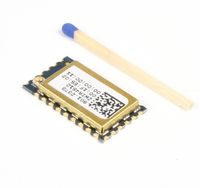Difference between revisions of "ICradio-ZWIR4512-OEM"
| Line 25: | Line 25: | ||
typedef enum { | typedef enum { | ||
PACKET_TYPE_DATA = 0x00, | PACKET_TYPE_DATA = 0x00, | ||
| − | PACKET_TYPE_BIND = 0x01, | + | PACKET_TYPE_BIND = 0x01, |
PACKET_TYPE_BINDACK = 0x02, | PACKET_TYPE_BINDACK = 0x02, | ||
PACKET_TYPE_UNBIND = 0x03, | PACKET_TYPE_UNBIND = 0x03, | ||
Revision as of 21:07, 21 January 2011
The ICradio ZWIR4512 OEM module is a | 6loWPAN radio module. The delivered 6LowPAN radio stack is able to build up a meshing network. Every node per default is relaying packets. So the user does not need to care about meshing. Just send packts to the nodes, the network will route the packets to the destination. The 6LowPAN Stack is delivered by ZMDi. It is a free for use software library in addition of some C-header files. For an easy startup with the ICradio ZWIR4512 OEM radio modules, In-Circuit deliveres the modules with an small application software. This software is connects to the UART and RF interfaces and handles some packets.
The Demo-Software implemets an UART-to-Radio protocol. For an easy use the pakets to the uart have to be send as hex-values as ASCII, meaning 0x00 ia send as "00". Only '0'-'9' and 'A'-'F' are accepted letters. Additionaly there is an 'Magic Word' - the letter 'S'. The 'S' is used as sync byte to start a packet. The packets to the UART alway have a fixed sceme:
- first letter is the 'S'
- followed by 2 bytes length of the packet (N + 1(type) +16(address))
- followed by 16 bytes IPv6 address of the destination, the IPv6 address ::1 is reserved for the Local Host. Packets to the ocal host are not sent over radio, but they are commands to the module.
- followed by 1 type-byte, that determines the type of the packet. When a module receives the packet, it decides with the type how to handle the packet data. There are several packet types pre-defined - as seen below.
- followed by N data bytes, that determines the type of the packet. When a module receives the packet, it decides with the type how to handle the packet data. There are several packet types pre-defined - as seen below.
Example: S00110000000000000000000000000000000105 S - sync letter 0011 - length = 0x11 = 17 bytes 00000000000000000000000000000001 - address = ::1 (IPv6 Local Host) 05 - type is 0x05 = discover-network command
This is the commad 0x05 to the Local Host. It is the command to discover the network - see below for available commands. The module executes the Stack command for scanning the network. When nodes are discovered, a callback routine is calles. The Demo-appication then gives out the address, ho-count and RSSI of the node. Example:
typedef enum {
PACKET_TYPE_DATA = 0x00, PACKET_TYPE_BIND = 0x01, PACKET_TYPE_BINDACK = 0x02, PACKET_TYPE_UNBIND = 0x03, PACKET_TYPE_SETUP = 0x04, PACKET_TYPE_DISCOVER_NETWORK = 0x05, PACKET_TYPE_DISCOVER_NETWORK_REPLY = 0x06, PACKET_TYPE_LED_DATA = 0x07, PACKET_TYPE_BTN_DATA = 0x08, PACKET_TYPE_GET_LOCAL_ADDRESS = 0x09, PACKET_TYPE_GET_LOCAL_ADDRESS_REPLY = 0x0A, PACKET_TYPE_SET_MAC_ADDRESS = 0x0B, //special type for use with ICradioPlug PACKET_TYPE_CONFIGURE_AS_PLUG = 0xF0,
} PACKET_TYPE_t;
Some special commands are also implemented and have to be sent via UART to the LOCAL-HOST (::1)
- scanning the network
S00110000000000000000000000000000000105
- getting the module's IPv6 address
S00110000000000000000000000000000000109
- setting the module's LED's
S001300000000000000000000000000000001070100 (set LED1=on, LED2=off) S001300000000000000000000000000000001070001 (set LED1=off, LED2=on)
